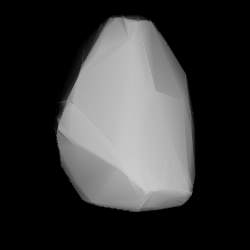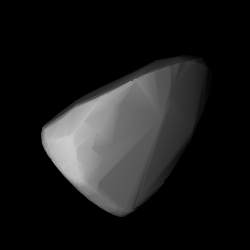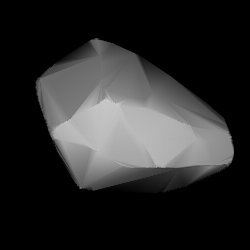Related Research Articles
Saskia, provisional designation 1900 FP, is a Themistian asteroid from the outer regions of the asteroid belt, approximately 44 kilometers in diameter. It was discovered on 22 October 1900, by German astronomer Max Wolf at the Heidelberg Observatory in southwest Germany. The X-type asteroid has a rotation period of 7.3 hours. It was named after Rembrandt's wife, Saskia van Uylenburgh.

759 Vinifera is a large background asteroid from the central regions of the asteroid belt, approximately 50 kilometers in diameter. It was discovered on 26 August 1913, by German astronomer Franz Kaiser at the Heidelberg-Königstuhl State Observatory in southwest Germany. The dark X-type asteroid has a rotation period of 14.2 hours and a heavily elongated shape. It was named after the plant species vitis vinifera, also known as the common grape vine.
971 Alsatia, provisional designation 1921 LF, is a carbonaceous background asteroid from the central region of the asteroid belt, approximately 60 kilometers in diameter. It was discovered on 23 November 1921, by French astronomer Alexandre Schaumasse at Nice Observatory in southeastern France. The asteroid was named after the French province Alsace.
Pawlowia, provisional designation 1923 OX, is a background asteroid from the central regions of the asteroid belt, approximately 20 kilometers in diameter. It was discovered on 5 October 1923, by Soviet astronomer Vladimir Albitsky at the Simeiz Observatory on the Crimean peninsula. The asteroid was named after Russian physiologist and Nobelist Ivan Pavlov.
1027 Aesculapia, provisional designation A923 YO11, is a Themistian asteroid from the outer region of the asteroid belt, approximately 33 kilometers in diameter.
1084 Tamariwa, provisional designation 1926 CC, is a carbonaceous background asteroid approximately 27 kilometres in diameter from the central regions of the asteroid belt. It was discovered on 12 February 1926, by Soviet astronomer Sergey Belyavsky at the Simeiz Observatory on the Crimean peninsula. The asteroid was named after female paratrooper Tamara Ivanova, who died at an early age.

1095 Tulipa is an Eos asteroid from the outer regions of the asteroid belt. It was discovered by German astronomer Karl Reinmuth at the Heidelberg-Königstuhl State Observatory in southwest Germany on 14 April 1926. The assumed S-type asteroid has a rotation period of 2.8 hours and measures approximately 30 kilometers in diameter. It was named after the flower Tulip. Originally, the name was redundantly assigned to Florian asteroid 1449 Virtanen.

1554 Yugoslavia, provisional designation 1940 RE, is a stony Eunomian asteroid from the middle region of the asteroid belt, approximately 16 kilometres (9.9 mi) in diameter. It was discovered by Serbian astronomer Milorad Protić at Belgrade Astronomical Observatory, Serbia, on 6 September 1940. It was named for the former country of Yugoslavia.

1132 Hollandia, provisional designation 1929 RB1, is a stony asteroid from the middle region of the asteroid belt, approximately 27 kilometers in diameter. It was discovered on 13 September 1929, by Dutch astronomer Hendrik van Gent at Leiden Southern Station, annex to the Johannesburg Observatory in South Africa. It was named for the region Holland in the Netherlands.

1137 Raïssa is a stony background asteroid and slow rotator, approximately 22 kilometers in diameter, located in the inner regions of the asteroid belt. It was discovered by Grigory Neujmin at Simeiz Observatory in 1929, and named in memory of Raïssa Maseeva, who worked at the Pulkovo Observatory.
1146 Biarmia, provisional designation 1929 JF, is a metallic background asteroid from the outer regions of the asteroid belt, approximately 32 kilometers in diameter. It was discovered on 7 May 1929, by Russian astronomer Grigory Neujmin at the Simeiz Observatory on the Crimean peninsula. The asteroid was named for the Bjarmaland mentioned in Norse sagas.
1152 Pawona, provisional designation 1930 AD, is a stony Vestian asteroid from the inner regions of the asteroid belt, approximately 16 kilometers in diameter. Discovered by Karl Reinmuth at Heidelberg Observatory in 1930, the asteroid was named in honor of astronomers Johann Palisa and Max Wolf.
1166 Sakuntala, provisional designation 1930 MA, is a stony background asteroid from the central regions of the asteroid belt, approximately 26 kilometers in diameter. Discovered by Praskovjya Parchomenko at Simeiz Observatory in 1930, the asteroid was named after the figure of Shakuntala from an ancient Indian drama.
1194 Aletta, provisional designation 1931 JG, is a carbonaceous asteroid from the outer region of the asteroid belt, approximately 55 kilometers in diameter. It was discovered on 13 May 1931, by South African astronomer Cyril Jackson at Johannesburg Observatory in South Africa. It was later named after the discoverer's wife Aletta Jackson.

1294 Antwerpia (prov. designation: 1933 UB1) is a dark background asteroid from the central regions of the asteroid belt. It was discovered on 24 October 1933, by astronomer Eugène Delporte at the Royal Observatory of Belgium in Uccle. The carbonaceous C-type asteroid has a rotation period of 6.6 hours and measures approximately 35 kilometers (22 miles) in diameter. It was named for the Belgian city of Antwerp.

1175 Margo, provisional designation 1930 UD, is a stony background asteroid from the outermost regions of the asteroid belt, approximately 24 kilometers in diameter. It was discovered on 17 October 1930, by astronomer Karl Reinmuth at the Heidelberg-Königstuhl State Observatory in southwest Germany. The meaning of the asteroids's name is unknown.
2043 Ortutay, provisional designation 1936 TH, is a dark asteroid from the outer regions of the asteroid belt, approximately 45 kilometers in diameter. The asteroid was discovered by Hungarian astronomer György Kulin at the Konkoly Observatory, Budapest, on 12 November 1936. It was named after Hungarian ethnographer Gyula Ortutay.
1305 Phongolo, provisional designation 1928 OC, is a background asteroid from the outer regions of the asteroid belt, approximately 25 kilometers in diameter. It was discovered on 19 July 1928, by English astronomer Harry Edwin Wood at the Union Observatory in Johannesburg, South Africa. The asteroid was named for the South African Pongola River.
For other uses, see Steel (disambiguation).
1708 Pólit, provisional designation 1929 XA, is a very dark asteroid from the outer region of the asteroid belt, approximately 29 kilometers in diameter. It was discovered on 30 November 1929, by Spanish astronomer of Catalan origin Josep Comas i Solà at the Fabra Observatory in Barcelona, and was later named after Catalan astronomer Isidre Pòlit i Boixareu.
References
- 1 2 3 4 "JPL Small-Body Database Browser: 1044 Teutonia (1924 RO)" (2017-02-24 last obs.). Jet Propulsion Laboratory . Retrieved 30 June 2017.
- 1 2 3 Schmadel, Lutz D. (2007). "(1044) Teutonia". Dictionary of Minor Planet Names – (1044) Teutonia. Springer Berlin Heidelberg. p. 89. doi:10.1007/978-3-540-29925-7_1045. ISBN 978-3-540-00238-3.
- 1 2 3 4 Tedesco, E. F.; Noah, P. V.; Noah, M.; Price, S. D. (October 2004). "IRAS Minor Planet Survey V6.0". NASA Planetary Data System. 12: IRAS-A-FPA-3-RDR-IMPS-V6.0. Bibcode:2004PDSS...12.....T . Retrieved 22 October 2019.
- 1 2 3 4 5 "LCDB Data for (1044) Teutonia". Asteroid Lightcurve Database (LCDB). Retrieved 30 June 2017.
- 1 2 3 4 Usui, Fumihiko; Kuroda, Daisuke; Müller, Thomas G.; Hasegawa, Sunao; Ishiguro, Masateru; Ootsubo, Takafumi; et al. (October 2011). "Asteroid Catalog Using Akari: AKARI/IRC Mid-Infrared Asteroid Survey". Publications of the Astronomical Society of Japan. 63 (5): 1117–1138. Bibcode:2011PASJ...63.1117U. doi:10.1093/pasj/63.5.1117. (online, AcuA catalog p. 153)
- 1 2 3 Masiero, Joseph R.; Grav, T.; Mainzer, A. K.; Nugent, C. R.; Bauer, J. M.; Stevenson, R.; et al. (August 2014). "Main-belt Asteroids with WISE/NEOWISE: Near-infrared Albedos". The Astrophysical Journal. 791 (2): 11. arXiv: 1406.6645 . Bibcode:2014ApJ...791..121M. doi:10.1088/0004-637X/791/2/121 . Retrieved 30 June 2017.
- 1 2 3 4 Mainzer, A.; Grav, T.; Masiero, J.; Hand, E.; Bauer, J.; Tholen, D.; et al. (November 2011). "NEOWISE Studies of Spectrophotometrically Classified Asteroids: Preliminary Results". The Astrophysical Journal. 741 (2): 25. arXiv: 1109.6407 . Bibcode:2011ApJ...741...90M. doi:10.1088/0004-637X/741/2/90.
- 1 2 Betzler, Alberto Silva; Ferreira, Diogo Henrique; Dos Santos, Tarcio Henrique Ribeiro; Novaes, Alberto Brum (March 2008). "Lightcurve and Rotation Period of 1044 Teutonia". The Minor Planet Bulletin. 35 (1): 26. Bibcode:2008MPBu...35...26B. ISSN 1052-8091 . Retrieved 30 June 2017.
- 1 2 Waszczak, Adam; Chang, Chan-Kao; Ofek, Eran O.; Laher, Russ; Masci, Frank; Levitan, David; et al. (September 2015). "Asteroid Light Curves from the Palomar Transient Factory Survey: Rotation Periods and Phase Functions from Sparse Photometry". The Astronomical Journal. 150 (3): 35. arXiv: 1504.04041 . Bibcode:2015AJ....150...75W. doi:10.1088/0004-6256/150/3/75 . Retrieved 30 June 2017.
- 1 2 Behrend, Raoul. "Asteroids and comets rotation curves – (1044) Teutonia". Geneva Observatory . Retrieved 30 June 2017.
- ↑ Klinglesmith, Daniel A. III; Hanowell, Jesse; Risley, Ethan; Turk, Janek; Vargas, Angelica; Warren, Curtis Alan (July 2014). "Lightcurves for Inversion Model Candidates". The Minor Planet Bulletin. 41 (3): 139–143. Bibcode:2014MPBu...41..139K. ISSN 1052-8091 . Retrieved 30 June 2017.
- ↑ Klinglesmith, Daniel A. III (January 2017). "Asteroid Photometry Results from Etscorn Observatory". The Minor Planet Bulletin. 44 (1): 69–72. Bibcode:2017MPBu...44...69K. ISSN 1052-8091 . Retrieved 30 June 2017.
- 1 2 "1044 Teutonia (1924 RO)". Minor Planet Center. Retrieved 30 June 2017.